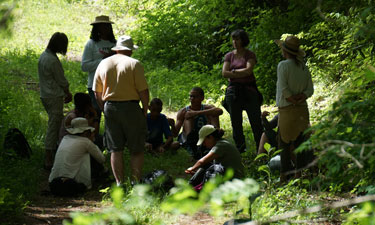 Many park visitors enjoy a walk in the woods, sometimes with a nature guide. But, two California state parks are offering a very different experience with guided forest therapy walks. With a forest therapy walk, “there’s a lot more intention to it,” says Amos Clifford, founder of the Association of Nature and Forest Therapy Guides and Programs. “It’s a practice that has to do with developing sensory awareness, using the senses as a way to intentionally invite in the healing power of the forest.”
Many park visitors enjoy a walk in the woods, sometimes with a nature guide. But, two California state parks are offering a very different experience with guided forest therapy walks. With a forest therapy walk, “there’s a lot more intention to it,” says Amos Clifford, founder of the Association of Nature and Forest Therapy Guides and Programs. “It’s a practice that has to do with developing sensory awareness, using the senses as a way to intentionally invite in the healing power of the forest.”
Forest therapy originated in Japan, where a practice known as Shinrin Yoku, literally “forest bathing,” was recognized by the Forest Agency (the equivalent of the U.S. Forest Service) in the 1980s. The Japanese Society of Forest Medicine was created by a highly credentialed group of scientists and medical doctors to promote research on forest medicine, including the therapeutic effects of forests on human health. The science behind the practice is based on breathing in phytoncides (wood essential oils), which are antimicrobial volatile organic compounds derived from trees. Forest therapy is now recognized in Japan as a stress management activity.
The practice came to the United States through Clifford, a longtime wilderness guide who had led wilderness trips for troubled youth and was looking for a way to bring the beneficial effects of nature to a wider audience. He started leading forest therapy walks in Sonoma County, California, and founded the Association of Nature and Forest Therapy Guides and Programs, which trains forest therapy guides from around the world.
On a forest therapy walk, says Clifford, “We would offer a series of invitations to guide you into a deeper awareness of your senses, what is around you and what is inside you — and doing that in a way that’s very gentle.” One invitation is to walk slowly for 15 or 20 minutes and observe what is in motion in the park — a rushing stream, a rustling of wind in the trees, perhaps a lizard skittering along the bank of the stream.
“When we do that, the body and mind naturally start calming down,” Clifford says. Initially, people on the walk start stressing out, thinking about all the things they should be doing, and they become impatient or bored. It normally takes them about an hour to relax and become aware of the environment.
Clifford’s organization has offered forest therapy walks in partnership with Sugarloaf Ridge State Park for three years. The park was among those in California closed in 2011 because of state budget cuts. Since 2012, Sugarloaf has been managed by the Sonoma Ecology Center, a private nonprofit organization. The Center publicizes the walks on its events website.
“We talk a little about forest therapy,” says John Roney, manager of the Ecology Center. “It doesn’t take long for people to get the idea.”
The most common participant on the Sonoma County walks is a woman in her 50s or 60s, adds Clifford. “One reason is, they often feel excluded from other kinds of nature activities. They don’t want to do a 4-mile hike to the top of the mountain because they’re afraid they’ll hold everybody up, and they may not feel safe if they go by themselves.”
Roney appreciates that forest therapy walks “bring health benefits to people.” “We looked at the research that’s been done [in Japan and elsewhere] overseas about the health benefits, and it’s very compelling,” he says.
So compelling, in fact, that Roney plans to meet with the three biggest health providers in the area — Kaiser Permanente, Sutter Health and St. Joseph Health — to propose a program whereby doctors would prescribe forest therapy walks to their patients, who could then have the park fee waived. Roney hopes to roll out the program this summer in several California state and county parks.
In a similar public-private partnership, nonprofit Stewards of the Coast and Redwoods manages Armstrong Redwoods State Natural Reserve, which also offers forest therapy walks. Stewards Programs Coordinator Sequoia Etcheverry has led a couple of walks and plans more for the summer. She says she aims for people to experience a “deep nature connection.”
Etcheverry invites people on her walks to participate in simple activities, such as “follow your pleasure.” A participant may discover that the sunlight on her skin is bringing her joy, and Etcheverry encourages her to immerse herself in the experience and explore it for 10 or 15 minutes. People are invited to share their experience with the group afterward, an important part of the walk.
“People said, ‘I feel like I’m in a family,’” Etcheverry says. “And they were strangers half an hour before. Two of the women were in tears when they were sharing.”
Michele Luna, executive director of the Stewards program, is pleased the park can offer the forest therapy walks as a way to engage the community and offer the practice’s physical and mental health benefits. Stewards will also be part of the medical prescription program.
You don’t need a deep redwood forest to offer forest therapy walks.
“We did one in a city neighborhood three-quarters of a mile from the freeway, in a pocket park,” Clifford says. “We don’t need ideal conditions.”
Joan Mooney is a Washington, D.C.-based freelance writer.

